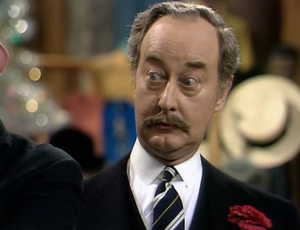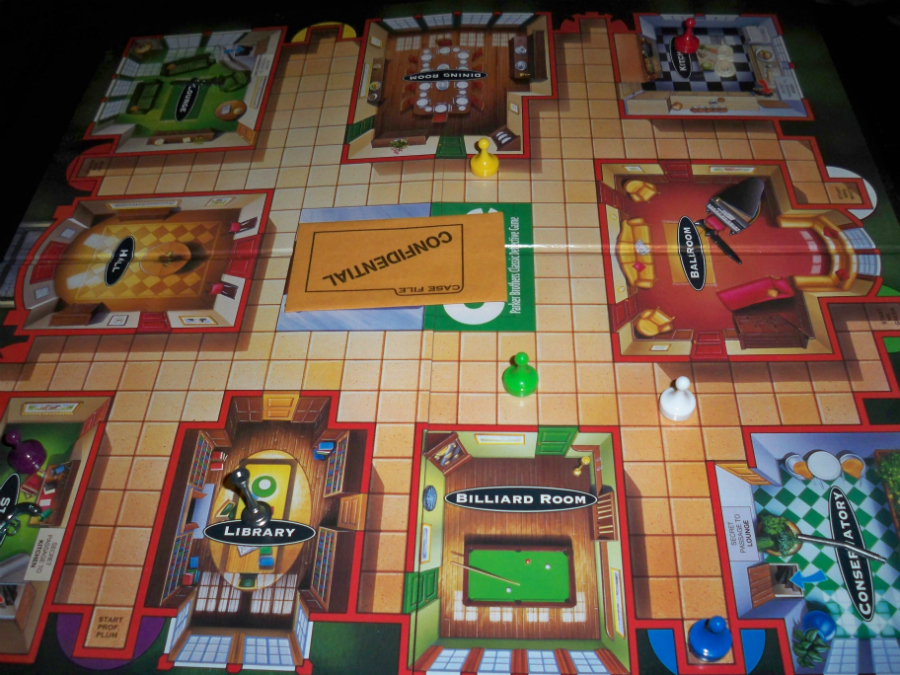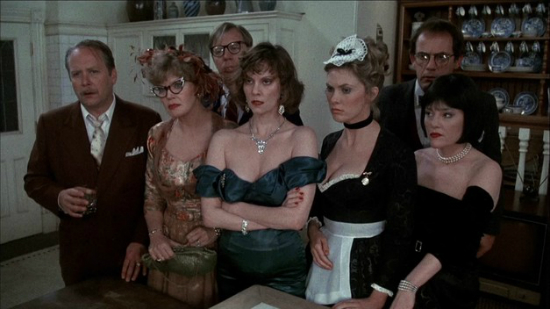All of the board games that we now consider the “Classics” were not the only games of the their times, and this notion tends to get lost in discussion. Each had competitors that were often surprisingly similar in theme, in setup, and sometimes even in game pieces. There were the abstract strategy games, trivia games, war games, and Roll And Move games, each imparting different lessons to its players: tactical placement, positional advantage, the rewards of seemingly needless knowledge, the inherent evils of capitalism…
What makes the games we remember “Classics” is the simple fact that due to a certain level of strategy, rules clarity, or more often, just marketing, these are the ones that endured in the cultural mindset while their competitors have been forgotten. In effect, these were the best games of their eras, and they’ve stuck around as a result.
A Party to Die For
When it comes to teaching deductive reasoning, however, nothing even approaches the level of public consciousness like Clue. It made its introduction in 1949 in Britain under the name Cluedo, which was a play on the word “ludo”, a Latin word for “game”, and also the name of a popular game in England at the time (ah yes… a British pun). Since then, generations of players have been journeying to the Boddy Mansion for a dinner party, and, on a dark and stormy night, try to find out which of their fellow guests have committed a heinous murder.
For those who somehow have never played, each player takes one of the six characters who offer no mechanical differences except name and starting location. Mr. Green doesn’t move any faster than Mrs. Peacock, nor does Colonel Mustard’s military history give him any advantages.
Players compete against each other to determine who killed Mr. Boddy, in which room on the board it happened, and what the murder weapon was. These three variables are represented by a stack of cards, each having a Suspect, Weapon or Room. One of each is randomly chosen and put unseen in a little envelope in the center of the board. The remainder of the cards are shuffled together and dealt out as evenly as possible amongst the players. Players also receive a sheet to keep track of their investigation.
From here on out, it’s a process of elimination. If you hold cards labeled “Kitchen”, “Study”, “Lead Pipe” and “Professor Plum”, then you know that those cards can’t be in the envelope, and so aren’t a part of the solution. Every turn, a player rolls a die to move their piece. Once per turn, if they are inside a room, they may make a guess about the solution that must include the room they’re in:
“I think… it might be Miss Scarlet, with the revolver, in the kitchen.”
 Starting to the player’s left, each opponent must try to disprove the theory by revealing one card to the guessing player (and only that player) that matches part of the guess. If they do, the guessing player marks it on their sheet and end their turn. If that player can’t, the next player tries, and so on.
Starting to the player’s left, each opponent must try to disprove the theory by revealing one card to the guessing player (and only that player) that matches part of the guess. If they do, the guessing player marks it on their sheet and end their turn. If that player can’t, the next player tries, and so on.
Once per game, you may try to declare your solution on your turn. This may be done anywhere on the board. Declare your solution, then secretly look at the cards in the envelope. If they completely match your guess, you’ve solved the mystery and have won the game! If not, put the cads back, and you are effectively out the running. Stick around though; you’ll still be needed to show the cards in your hand.
It’s All An Allusion
So, what explains Clue’s enduring popularity? Its a relatively simple game with an appealing theme, true, but the real staying power lies with its colorful cast of characters. Each suspect is memorable, even though it never manifests itself within the mechanics of the game, and it’s not simply just for their namesakes. Each of the characters is a murder-mystery trope unto themselves, instantly recognizable to fans of Agatha Christie, the mystery genre in general, or PBS/ BBC programming:
- Miss Scarlet is the sexy debutante, a charming and intelligent femme fatale.
- Mr. Green is the “legitimate businessman”, the kind who made his fortune with certain “business interests” back East. In the original British editions, the character was known as Reverend Green, but Parker Brothers changed the name when they produced the American version. (Apparently, they thought the American public wouldn’t be able to accept a pastor as a murder suspect.)
-
Mrs. Peacock is the heiress, older and aristocratic.
- Colonel Mustard is seen as the dignified retired military man, though sometimes he’s more of the eccentric “Great White Hunter”.
- Professor Plum is the absent minded professor.
- Mrs. White is the overworked maid.
Each one was an amalgamation of known or recognizable characters, so Clue was already familiar ground. This is often overlooked. People latch onto something much faster and easier if the subject material feels familiar.
The popular sci-fi game Twilight Imperium, for example, is a very complex game of board domination. Players who are already fans of various science fiction universes often have an easier time grasping the basics of it, as they’ve already been exposed to the concepts behind the various species and strategies presented. Immediate recognition is an important part of branding. Even in Clue’s first printing, the image of the wealthy(ish) socialites gathered by an ornate fireplace in a mansion immediately struck a chord with the general public. Presented here was something many tacitly understood before playing their first game.
Boddy Issues
Playing Clue is relatively simple, but it is not without faults. For instance, many players become frustrated with the rule that automatically moves your character to the room of the player making a guess if your character is the one named in their suspicions. In this way, players can have their attempts to reach a particular room constantly stymied (even more so than the unpredictable dice rolls), particularly if multiple opponents are working in concert. While this admittedly can be a tactic to hold back a particularly strong player, it often isn’t as game-changing as it appears. In the end, it’s more a needless annoyance than anything else.
Faults exist on the thematic side of the game as well. Immersionists will have to contend with several “plot holes”. While Clue does a fantastic job at being an homage to the murder mystery genre it’s representing, some Immersionists can get hung up on the more incongruous elements in the game. Ignoring the question of where the police are during all of this, or why it takes so much more effort to move about in the corridors than hopping from room to room, and instead concentrating on the investigation itself, one has to wonder about some of the finer details.
It’s understandable in trying to find out where the murder took place via empirical evidence, as it realistically can be difficult to nail down the murder location if a body is moved. The murder weapon should be far less difficult to ascertain, however. A rope, a knife and a gun all leave very different marks on the body. If Mr. Boddy was bludgeoned by a blunt object, wouldn’t it be incredibly easy to rule out a handful of weapons immediately instead of having to deduce them through the game’s mechanics?
Additionally, there is the issue of having to rationalize away the situation where you win the game by declaring that your character is, in fact, the murderer. Possible explanations could go something along the lines of:
(Overwhelming Guilt) – “Oh my God, I never meant for this to happen! I’m so sorry…”
(Sudden Onset Amnesia) – “Hey guys, I just remembered, I did it! Umm, whoops?”
(Split Personality) – “It was my evil twin who shares my body this whole time!”
or
(Megalomania) – “Hahaha, you simple fools! It was me all along! It was ME!!!!”
I Would Have Gotten Away With It Too If. . .
This game of deductive reasoning’s biggest weakness, though, is, well, players who have a strong grasp of deductive reasoning. The way most people play the game is simply to focus on the information you have available through cards in your hand and cards shown to you, not really paying much attention during other players’ turns. However, it is possible to reliably beat the game in five turns or less using strong deductive reasoning.
A deductive player’s scoring sheet helps them keep track of what has and hasn’t been explicitly shown to be incorrect, but it is possible to keep track of what other players may or may not have revealed. For instance, if a player makes a suggestion, and the opponent to their left cannot disprove it, the deductive player can mark off those three named cards as “Not in X’s Hand”. Conversely, if they do reveal a card, then you can mark down that one of the three mentioned is there. If you can keep track of what each player could be holding in their hand, you will always arrive to the conclusion far ahead of the rest of the table.
This extension of deductive logic may seem an obvious one in hindsight, but in a casual or family game environment, announcing the correct answer in the first ten minutes will first engender suspicion, then awe, then a desire to never play against you again. This approach will catch the attention of Tacticians and Strikers who enjoy games of mental sparring. At the same time, it pushes away Socializers, as it requires paying a decent amount of attention (an uncommon trait for classic family-style games) and Daredevils, who will feel trapped in a game that, in some ways, is one big logic puzzle with some great window dressing. Similarly, Architects won’t be put off by the issues of discerning the murderer so much as, that like many games of this era, there is little for them to do since the only resource for them to collect is information.
There have been a number of different variations released over the years, many merely attempts to update or “modernize” the theme. It is a testament to the enduring legacy of Clue that at this date there have been almost 40 official editions, variants and spinoff games, ranging in location from a carnival to Paris, from board games to card games and video games. There have been several television series and even a broadway show where cards randomly selected by audience members tailored the show’s progression to fit any selection, leading to 216 different endings.
Oh, and the epitome of it all, a cult movie classic:
Modern players may tire of the roll-and-move gameplay and uncontrolled teleportation aspects of Clue, but there is no denying this family classic has enjoyed widespread appeal. Indeed, Clue has held up slightly better over time than many other iconic classic games. In many ways, it was ahead of its time since so much of the game’s win condition is based around the player’s actions more so than the random dice roll (though that still plays a large factor). It provided hints even back then that people could enjoy a game that relied on more than sheer chance to win a game And we’ll raise a candlestick to that.
Photo Credits: Clue cover by Kevin Wada; Hot Fuzz by Movies, Films & Flix; Cat meme by I can has cheezburger; Peacock by AYBS Wikia; Clue: the Movie by AV Club.




